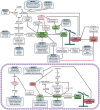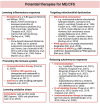Myalgic Encephalomyelitis/Chronic Fatigue Syndrome: the biology of a neglected disease
- PMID: 38887284
- PMCID: PMC11180809
- DOI: 10.3389/fimmu.2024.1386607
Myalgic Encephalomyelitis/Chronic Fatigue Syndrome: the biology of a neglected disease
Abstract
Myalgic Encephalomyelitis/Chronic Fatigue Syndrome (ME/CFS) is a chronic, debilitating disease characterised by a wide range of symptoms that severely impact all aspects of life. Despite its significant prevalence, ME/CFS remains one of the most understudied and misunderstood conditions in modern medicine. ME/CFS lacks standardised diagnostic criteria owing to variations in both inclusion and exclusion criteria across different diagnostic guidelines, and furthermore, there are currently no effective treatments available. Moving beyond the traditional fragmented perspectives that have limited our understanding and management of the disease, our analysis of current information on ME/CFS represents a significant paradigm shift by synthesising the disease's multifactorial origins into a cohesive model. We discuss how ME/CFS emerges from an intricate web of genetic vulnerabilities and environmental triggers, notably viral infections, leading to a complex series of pathological responses including immune dysregulation, chronic inflammation, gut dysbiosis, and metabolic disturbances. This comprehensive model not only advances our understanding of ME/CFS's pathophysiology but also opens new avenues for research and potential therapeutic strategies. By integrating these disparate elements, our work emphasises the necessity of a holistic approach to diagnosing, researching, and treating ME/CFS, urging the scientific community to reconsider the disease's complexity and the multifaceted approach required for its study and management.
Keywords: diagnostic criteria; myalgic encephalomyelitis/chronic fatigue syndrome; pathology; pathophysiology; treatment.
Copyright © 2024 Arron, Marsh, Kell, Khan, Jaeger and Pretorius.
Conflict of interest statement
The authors declare that the research was conducted in the absence of any commercial or financial relationships that could be construed as a potential conflict of interest.
Figures













References
-
- S. Committee on the Diagnostic Criteria for Myalgic Encephalomyelitis/Chronic Fatigue. P. Board on the Health of Select and M. Institute of, The National Academies Collection . Reports funded by national institutes of health, beyond myalgic encephalomyelitis/Chronic fatigue syndrome: redefining an illness, national academies press (US). Washington (DC: National Academy of Sciences; (2015).
-
- Bateman L, Darakjy SS, Klimas NG, Peterson DL, Levine SM, Allen A, et al. . Chronic fatigue syndrome and co-morbid and consequent conditions: evidence from a multi-site clinical epidemiology study. Fatigue: Biomedicine Health Behav. (2015) 3:1–15. doi: 10.1080/21641846.2014.978109 - DOI
Publication types
MeSH terms
LinkOut - more resources
Full Text Sources
Other Literature Sources

